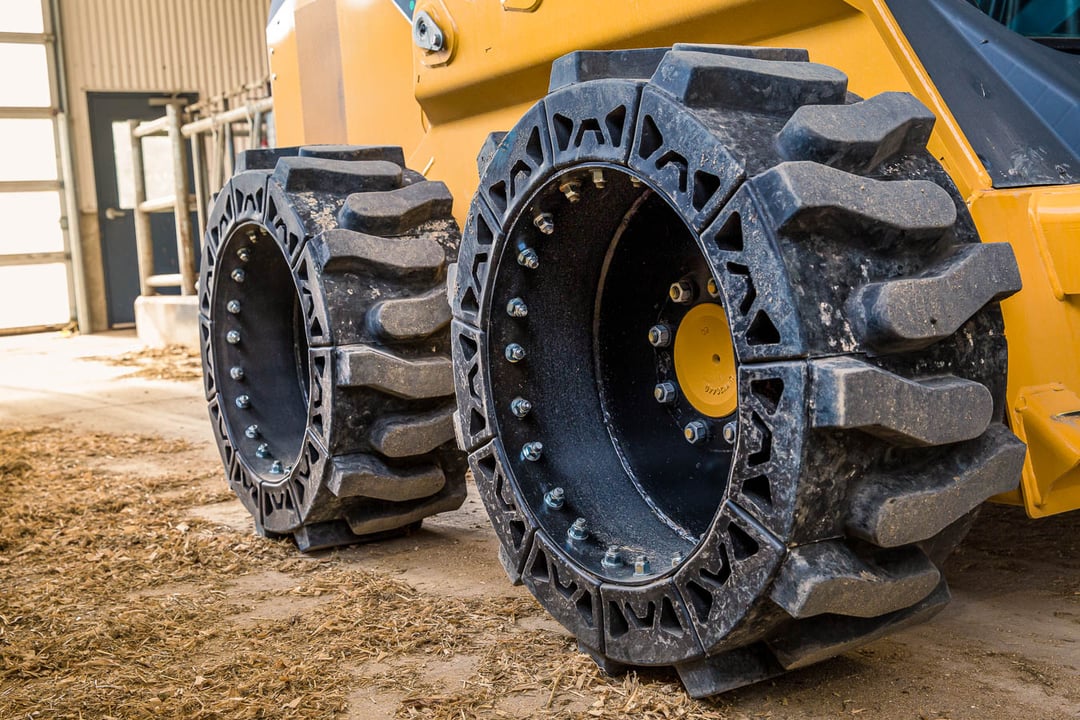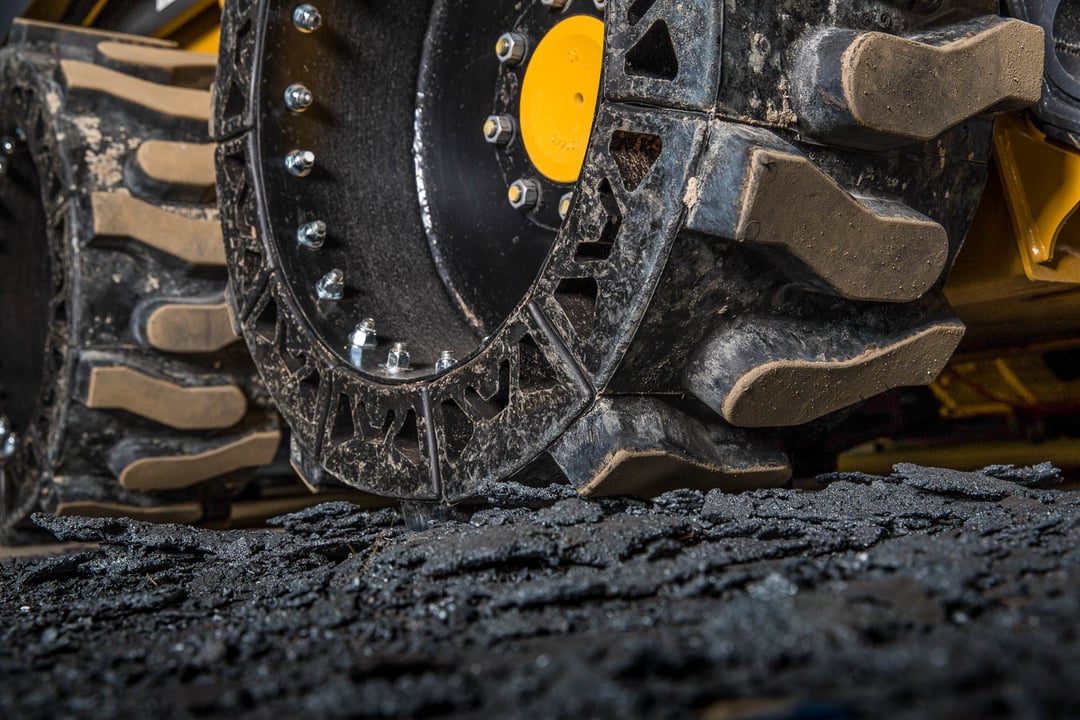What are the Different Types of Skid Steer Tires?
There are many different tires of skid steer tires out there. Traditional pneumatic tires are still by far the most common however more and more premium options are entering the market every year.
Pneumatic and Solid Tires
Pneumatic tires are the most common tire you will see on a job site. These tires are great for standard applications on dirt and turf and for infrequent use however wear fast as applications get more severe. When a skid steer is used daily and in severe-duty applications like on asphalt and mining, pneumatic tires get damaged easily and will go flat. This is why you are seeing more solid tires being used in these applications.
Solid skid steer tires are well suited for heavy-duty applications like demolition and asphalt. These tires are flat-proof and puncture-proof, so you don't have to worry about them going flat. That being said, many of these tires are rigid and don’t compress easily. This results in a rough ride for the operator. A tire with core geometry like in the EWRS-AT and HS allows the tire to compress like a pneumatic would while maintaining all the flat and puncture-free properties as a pneumatic tire.

There are many core geometry designs in the market. The most common are round and oval apertures. These designs are less expensive to manufacture, but they do not provide the compression that many operators are looking for. A specially engineered core geometry like the one featured on the EWRS-AT and HS Series is specifically designed to mimic the compression of a pneumatic tire.
Tread Design
All-Terrain Skid Steer Tires: When working on soft ground like dirt, an all-terrain tire is the right option for you. These tread patterns will give you good traction on soft ground however when operating on hard surfaces, they will wear quickly. When looking for an all-terrain tire avoid ones that use a center wear bar. When a tire's tread is too small, a central wear bar is necessary for structural support; however, it will reduce traction once the tire is 50% worn.
Mud Skid Steer Tires: Muddy conditions are much softer than dirt or sandy soils. This is where a more heavy-duty tire is needed. Tires with large lugs and void spaces are ideal for these applications due to the increased traction and material cleanout. These tires are also likely to wear out quickly on hard surfaces, like all-terrain tires.
Hard Surface Skid Steer Tires: These tires are designed to maximize wear life on hard surfaces. If you are operating on asphalt, concrete, or any other hard surface, these are what you are looking for. By increasing the lifespan of your tires, some traction will be lost. Many of these tires still have lugs to maintain some traction so you can get around easier. Typically, they are more expensive than an all-terrain tire but pay off in the long run due to their increased lifespan.
Smooth Skid Steer Tires: When operating in conditions where traction isn’t a concern, a smooth skid steer tire is the way to go. These tires are completely flat maximizing ground contact, and spreading the load over a larger area. This in turn maximizes wear life.
Turf Skid Steer Tires: The most suitable option when operating over grass and ground that needs to be protected. These tires are used when working on lawns and landscaping since they don’t cut into the ground as a mud tire would.

Types of Solid Tire Mounts
There are three main types of solid tire mounts used on skid steer tires. Pressed-on, Bonded-on, and segmented.
Pressed-on Tires
Pressed-on tires refer to solid tires that are pressed onto an existing rim. These tires have a lower upfront cost, however, can fail under heavy loads. To mount these tires, you need special equipment and likely a specialized tire shop that has the machinery required for this. They can fail in wet conditions because water acts as a lubricant between the rubber and the rim.
Bonded Solid Tires
These tires chemically bond the rubber and the rim together to avoid the slippage that pressed-on tires have. These tires are more expensive up front and when it comes to replacing them, they require the replacement of both the rubber and the rim.
Segmented solid skid steer tires like the EWRS-AT and HS series allow for serviceability. These types of tires are composed of rubber segments that are bolted onto the rim. This allows the operator the ability to change them out on their own with only a wrench. If a segment is damaged you only need to change the damaged segment and when the tire needs new rubber, the operator can easily mount them onto the tire. This limits downtime and eliminates tires to the tire shop. The added benefit is that a full replacement set is often only about 70% of the initial cost.
The EWRS-AT and EWRS-HS Series Solid Skid Steer Tires
Everyone's situation is different. However, if you are looking to upgrade your skid steer tires for a high-performance, long-lasting option, the EWRS-AT or EWRS-HS Series solid skid steer tires may be for you. These tires are flat-free, segmented for serviceability, and are made with the highest quality ingredients. They feature specially designed core geometry and a 52/32" lug depth for longevity. Lasting 3-5 times longer than premium pneumatic skid steer tires.
Related Pages
If this page was informative, check these out:
- High Performance Skid Steer Tires
- Minimize Construction Delays with Solid Skid steer Tires
- How To Maintain Your Skid Steer Tires
- Solid Skid Steer Tires Prices


.jpg?width=1080&height=810&name=BOBCAT%20S570%20EWRS-HS%20(2).jpg)
